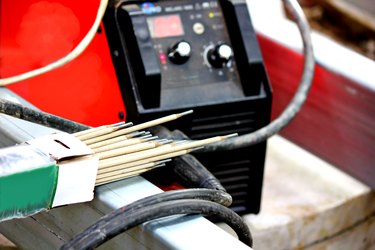
Welding is a process that uses a welding gun and electrode, or rod. The welding gun produces an electrical charge that is sent down the rod. The resulting electric current then melts and binds the metals it is applied to. There are multiple welding rods that welders use, depending on the current and type of material. The American Welding Society specifies a standardized numbering system to label and identify welding rods.
Shielded Metal Arc Welding or Stick
Video of the Day
Shielded Metal Arc Welding or Stick (SMAW) welding rods are a type of consumable electrode. This means that as you are welding, the electrode melts and binds with the metal pieces. Since they are consumable, they do need to be replaced. These electrodes are labeled with the letter E, followed by a four or five-number sequence.
Video of the Day
The letter E indicates that the rod will carry an electric current. The next number is either two or three digits, depending on whether the entire number is four or five digits respectively, indicating the tensile strength of the electrode. Tensile strength measures the amount of force a material can withstand before it breaks.
The next number indicates the position that the rod can be used in. The number 1 indicates that you can weld in any position, while a 2 indicates that you must use the rod in a horizontal position. The number 4 indicates the rod can be used in a vertical position. The final number in the sequence tells you the coating of the rod and the current you can use with the electrode.
SMAW Coating and Current Codes
The numbers 0 through 8 are used to indicate the coating and current of the electrode. The number 0 is a high cellulose sodium rod that can be used with DC+ current. If the rod is labeled with a number 1, it is a high cellulose potassium electrode that can be used with any type of current. The number 2 indicates a high titania sodium rod that can be used with AC or DC- currents. The number 3 indicates a high titania potassium rod that can be used with AC or DC+ currents.
Rods with the number 4 are iron powder and titania rods that can be used with any type of current. Rods with the number 5 are low hydrogen sodium electrodes for use with DC+ currents. The number 6 indicates a low hydrogen potassium electrode that can be used with AC or DC+ currents.
Rods with the number 7 are high iron oxide and iron powder electrodes, and rods with the number 8 are low hydrogen potassium and iron powder electrodes. Both of these can be used with any type of current.
FCAW Electrode Numbers
Flux-cored arc welding (FCAW) rods are another type of consumable rod with a similar numbering system. The number starts with the letter E, which again indicates that the rod carries a current. The next number indicates the tensile strength of the rod. The next number indicates the welding position that can be used with the rod. The number 0 means it can be used in any position, and 1 means it should be used in a horizontal position.
Next in the sequence is the letter T, which indicates it is a tubular electrode. There is a dash, then the next number ranging from 1 to 14 indicates the usability of the electrode. For example, T-1 indicates that the rod is a tubular electrode with rutile flux that can be used with DC+ current.
The final letters indicate the type of shielding gas that can be used with the electrode. For example, C/M means that the rod can be used with both carbon dioxide (C) or a mixture of gases (M) such as carbon dioxide and argon.